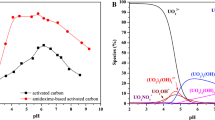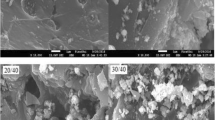Abstract
Biomass is one of the most important carbon raw due to high availability and low cost. In this study mesoporous biomass carbon adsorbent derived from Luffa chemically modified with task-specific amidoxime group (Luffa-AO for short) was prepared. Luffa-AO was verified using SEM, TEM, FT-IR, N2 adsorption–desorption isotherm and X-ray photoelectron spectroscopy (XPS). The effects of operational parameters such as pH, mixing time, initial uranium concentration, temperature and recycle time on the adsorption of U(VI) with Luffa-AO were studied. The results showed that the saturation adsorption amount qmax reached 247.58 mg g−1, a competitive adsorption ability compared with the values reported in the previous references. Kinetics, isotherm and thermodynamics were investigated. The variation in binding energy elucidated with XPS indicated nitrogen and oxygen atoms involved in the process of complexing uranium. The study expanded the application fields of Luffa biomass and enriched the list of uranium adsorbents.











Similar content being viewed by others
References
Basar S, Tosun B (2021) Environmental Pollution Index and economic growth: evidence from OECD countries. Environ Sci Pollut Res 28(27):36870–36879
Xu L, Deng YF, Mancl KR (2019) Environmental disaster risk reduction-oriented centralized treatment of hazardous wastes: a novel approach for production-distribution decision optimization in China. Int J Disaster Risk Reduct 40:101263
Ajiboye TO, Oyewo OA, Onwudiwe DC (2021) Simultaneous removal of organics and heavy metals from industrial wastewater: a review. Chemosphere 262:128379
Adeola FO (2011) Hazardous wastes, industrial disasters, and environmental health risks: local and global environmental struggles. Springer, Berlin
Asic A, Kurtovic-Kozaric A, Besic L, Mehinovic L, Hasic A, Kozaric M, Hukic M, Marjanovic D (2017) Chemical toxicity and radioactivity of depleted uranium: the evidence from in vivo and in vitro studies. Environ Res 156:665–673
Jayasinghe C, Molligoda V, Attanayaka T, Waduge V (2019) Estimation of annual effective dose due to ingestion of radioactive elements in Sri Lankan common meal plans. Environ Geochem Health 41(3):1123–1129
Faa A, Gerosa C, Fanni D, Floris G, Eyken PV, Lachowicz JI, Nurchi VM (2018) Depleted uranium and human health. Curr Med Chem 25(1):49–64
Shehzad H, Zhou LM, Wang Y, Ouyang JB, Huang GL, Liu ZR, Li Z (2019) Effective biosorption of U(VI) from aqueous solution using calcium alginate hydrogel beads grafted with amino-carbamate moieties. J Radioanal Nucl Chem 321(2):605–615
Foster RI, Amphlett JTM, Kim KW, Kerry T, Lee K, Sharrad CA (2020) SOHIO process legacy waste treatment: uranium recovery using ion exchange. J Ind Eng Chem 81:144–152
Da̧browski A, Hubicki Z, Podkościelny P, Robens E (2004) Selective removal of the heavy metal ions from waters and industrial wastewaters by ion-exchange method. Chemosphere 56(2):91–106
Bashir A, Malik LA, Ahad S, Manzoor T, Bhat MA, Dar G, Pandith AH (2019) Removal of heavy metal ions from aqueous system by ion-exchange and biosorption methods. Environ Chem Lett 17(2):729–754
Koliehova A, Trokhymenko H, Melnychuk S, Gomelya M (2019) Treatment of wastewater containing a mixture of heavy metal ions (copper–zinc, copper–nickel) using ion-exchange methods. Ecol Eng 20(11):146–151
Senol A (2014) Optimization of extractive removal of uranium(VI) from aqueous acidic solutions using commercial amines: linear solvation energy relation based modeling. Sep Purif Technol 131:35–49
Sen N, Darekar M, Sirsat P, Singh KK, Mukhopadhyay S, Shirsath SR, Shenoy KT (2019) Recovery of uranium from lean streams by extraction and direct precipitation in microchannels. Sep Purif Technol 227:115641
Liu C, Lei X, Wang L, Jia J, Liang X, Zhao X, Zhu H (2017) Investigation on the removal performances of heavy metal ions with the layer-by-layer assembled forward osmosis membranes. Chem Eng J 327:60–70
Chen X, Chen D, Li N, Xu Q, Li H, He J, Lu J (2020) Modified-MOF-808-loaded polyacrylonitrile membrane for highly efficient, simultaneous emulsion separation and heavy metal ion removal. ACS Appl Mater Interfaces 12(35):39227–39235
Xie J, Lv R, Peng H, Fan J, Tao Q, Dai Y, Zhang Z, Cao X, Liu Y (2020) Phosphate functionalized poly(vinyl alcohol)/poly(acrylic acid) (PVA/PAA): an electrospinning nanofiber for uranium separation. J Radioanal Nucl Chem 326(1):475–486
Chen R, Sheehan T, Ng JL, Brucks M, Su X (2020) Capacitive deionization and electrosorption for heavy metal removal. Environ Sci Water Res 6(2):258–282
Li Z, Zhang Z, Dong Z, Wu Y, Liu J, Cheng Z, Liu Y, Wang Y, Zheng Z, Cao X (2021) Synthesis of MoS2/Pg-C3N4 nanocomposites with enhanced visible-light photocatalytic activity for the removal of uranium(VI). J Solid State Chem 302:122305
Chaudhary M, Singh L, Rekha P, Srivastava VC, Mohanty P (2019) Adsorption of uranium from aqueous solution as well as seawater conditions by nitrogen-enriched nanoporous polytriazine. Chem Eng J 378:122236
Li BY, Sun Q, Zhang YM, Abney CW, Aguila B, Lin WB, Ma SQ (2017) Functionalized porous aromatic framework for efficient uranium adsorption from aqueous solutions. ACS Appl Mater Interfaces 9(14):12511–12517
Gholizadeh M, Hu X (2021) Removal of heavy metals from soil with biochar composite: a critical review of the mechanism. J Environ Chem Eng 9:105830
Bazan-Wozniak A, Pietrzak R (2020) Adsorption of organic and inorganic pollutants on activated bio-carbons prepared by chemical activation of residues of supercritical extraction of raw plants. Chem Eng J 393:124785
Qiu B, Tao X, Wang H, Li W, Ding X, Chu H (2021) Biochar as a low-cost adsorbent for aqueous heavy metal removal: a review. J Anal Appl Pyrol 155:105081
He LZ, Zhong H, Liu GX, Dai ZM, Brookes PC, Xu J (2019) Remediation of heavy metal contaminated soils by biochar: mechanisms, potential risks and applications in China. Environ Pollut 252:846–855
Bishay A (2010) Environmental application of rice straw in energy production and potential adsorption of uranium and heavy metals. J Radioanal Nucl Chem 286(1):81–89
Wang H, Gui R, Zhu W, Geng W, Chen J, Wu L (2020) Preparation process of straw-based activated carbon for uranium wastewater treatment. E3S Web Conf 185:04057
Belgacem A, Rebiai R, Hadoun H, Khemaissia S, Belmedani M (2014) The removal of uranium(VI) from aqueous solutions onto activated carbon developed from grinded used tire. Environ Sci Pollut Res 21(1):684–694
Yu DY, Wang LL, Wu MH (2018) Simultaneous removal of dye and heavy metal by banana peels derived hierarchically porous carbons. J Taiwan Inst Chem Eng 93:543–553
Hu H, Zhang X, Wang T, Sun LL, Wu HX, Chen XH (2018) Bamboo (Acidosasa longiligula) shoot shell biochar: its potential application to isolation of uranium(VI) from aqueous solution. J Radioanal Nucl Chem 316(1):349–362
Zhang X, Yu MY, Li YY, Cheng FF, Liu YQ, Gao MQ, Liu GL, Hu LG, Liang Y (2021) Effectiveness of discarded cigarette butts derived carbonaceous adsorbent for heavy metals removal from water. Microchem J 168:106474
Frutos I, Garcia-Delgado C, Garate A, Eymar E (2016) Biosorption of heavy metals by organic carbon from spent mushroom substrates and their raw materials. Int J Environ Sci Technol 13(11):2713–2720
Sutton J (1952) Configuration of the uranyl ion. Nature 169(4293):235–236
Shen H, Xia X, Ouyang Y, Jiao X, Mutahir S, Mandler D, Hao Q (2019) Preparation of biomass-based porous carbons with high specific capacitance for applications in supercapacitors. ChemElectroChem 6(14):3599–3605
Noor NM, Othman R, Mubarak NM, Abdullah EC (2017) Agricultural biomass-derived magnetic adsorbents: preparation and application for heavy metals removal. J Taiwan Inst Chem Eng 78:168–177
Hagemann N, Spokas K, Schmidt HP, Kägi R, Böhler MA, Bucheli TD (2018) Activated carbon, biochar and charcoal: linkages and synergies across pyrogenic carbon’s ABCs. Water Sui 10(2):182
Ma FQ, Dong BR, Gui YY, Cao M, Han L, Jiao CS, Lv HT, Hou JJ, Xue Y (2018) Adsorption of low-concentration uranyl ion by amidoxime polyacrylonitrile fibers. Ind Eng Chem Res 57(51):17384–17393
Liu P, Yu Q, Xue Y, Chen JQ, Ma FQ (2020) Adsorption performance of U(VI) by amidoxime-based activated carbon. J Radioanal Nucl Chem 324(2):813–822
Shao D, Li Y, Wang X, Hu S, Wen J, Xiong J, Marwani HM (2017) Phosphate-functionalized polyethylene with high adsorption of uranium(VI). ACS Omega 2(7):3267–3275
Taimur S, Hassan MI, Yasin T (2017) Removal of copper using novel amidoxime based chelating nanohybrid adsorbent. Eur Polym J 95:93–104
Rodrigues AE, Silva CM (2016) What’s wrong with Lagergreen pseudo first order model for adsorption kinetics? Chem Eng J 306:1138–1142
Gondhalekar SC, Shukla SR (2014) Equilibrium and kinetics study of uranium(VI) from aqueous solution by Citrus limetta peels. J Radioanal Nucl Chem 302(1):451–457
Zhao CS, Liu J, Tu H, Li FZ, Li XY, Yang JJ, Liao JL, Yang YY, Liu N, Sun Q (2016) Characteristics of uranium biosorption from aqueous solutions on fungus Pleurotus ostreatus. Environ Sci Pollut R 23(24):24846–24856
Xu ZM, Xing YX, Ren AR, Ma DD, Li YX, Hu SH (2020) Study on adsorption properties of water hyacinth-derived biochar for uranium(VI). J Radioanal Nucl Chem 324(3):1317–1327
Ai L, Luo X, Lin X, Zhang S (2013) Biosorption behaviors of uranium(VI) from aqueous solution by sunflower straw and insights of binding mechanism. J Radioanal Nucl Chem 298(3):1823–1834
Yi ZJ, Yao J, Xu JS, Chen MS, Li W, Chen HL, Wang F (2014) Removal of uranium from aqueous solution by using activated palm kernel shell carbon: adsorption equilibrium and kinetics. J Radioanal Nucl Chem 301(3):695–701
Ahmed W, Mehmood S, Qaswar M, Ali S, Khan ZH, Ying H, Chen DY, Nunez-Delgado A (2021) Oxidized biochar obtained from rice straw as adsorbent to remove uranium(VI) from aqueous solutions. J Environ Chem Eng 9(2):105104
Lu X, Zhang DX, Reda AT, Liu C, Yang Z, Guo SS, Xiao ST, Ouyang YG (2017) Synthesis of amidoxime-grafted activated carbon fibers for efficient recovery of uranium(VI) from aqueous solution. Ind Eng Chem Res 56(41):11936–11947
Acknowledgements
Financial supports from the National Natural Science Foundation of China (No. 22066001) and Natural Science Foundations of Jiangxi Province of China (No. 20202BABL213010).
Author information
Authors and Affiliations
Corresponding authors
Additional information
Publisher's Note
Springer Nature remains neutral with regard to jurisdictional claims in published maps and institutional affiliations.
Rights and permissions
About this article
Cite this article
Li, Y., Dai, Y., Gao, Z. et al. Adsorption of uranium onto amidoxime-group mesoporous biomass carbon: kinetics, isotherm and thermodynamics. J Radioanal Nucl Chem 331, 353–364 (2022). https://doi.org/10.1007/s10967-021-08115-x
Received:
Accepted:
Published:
Issue Date:
DOI: https://doi.org/10.1007/s10967-021-08115-x




